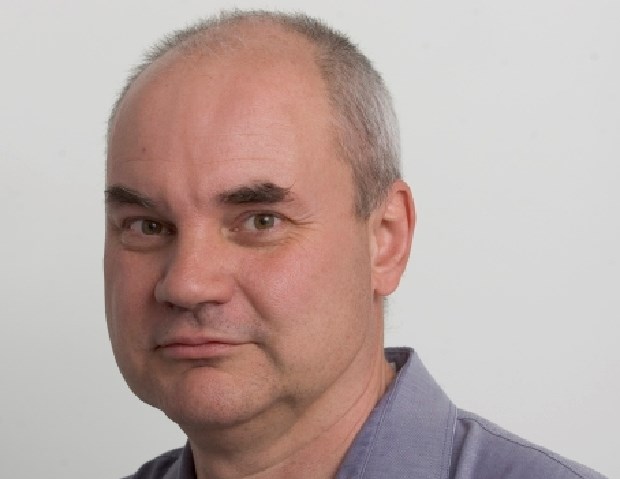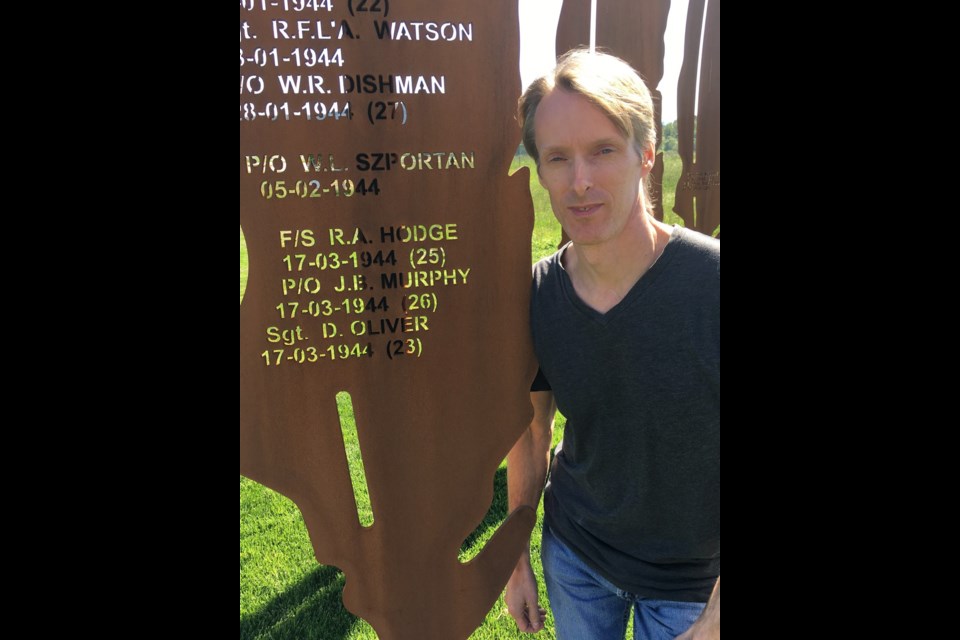 Winnipeg’s Gerry Hodge had already received the dreaded telegram once, the one that regretted to inform her that her husband, Roy, had been shot down over Europe and was presumed dead.
Winnipeg’s Gerry Hodge had already received the dreaded telegram once, the one that regretted to inform her that her husband, Roy, had been shot down over Europe and was presumed dead.
Except Roy was fine. The New Zealander had been rescued by the Belgian resistance, spirited over the Pyrenees, and sent back to Canada to train downy-cheeked newbies at the air force base in Victoria.
Gerry was pregnant with his child now.
So when Gerry got another message in 1944, this one saying Roy’s bomber had disappeared on a training flight from Patricia Bay airport, it was hard to believe.
It was true, though. She never saw her 25-year-old husband again. Daughter Sandy never got to meet her father.
And Sandy’s son George Watson never got to know his New Zealand family — until now, thanks to some sleuthing by one of the volunteers researching the almost-forgotten flyers who died while training at Patricia Bay.
Sculptor Illarion Gallant’s new Lost Airmen of the Empire monument sits atop Hospital Hill on the north side of Victoria airport, off Mills Road overlooking Patricia Bay. It lists 179 names, including those of three women. More members of the military died while training at Patricia Bay in the Second World War than were killed in Canada’s 12-year mission to Afghanistan.
Few know that, though. The Patricia Bay Air Station might have been Canada’s third-largest wartime airfield, 10,000 Allied airmen awkwardly bumping down the runway as they learned to fly the planes they would take into battle, but no one really set out to tell the tale of those 179 souls until Doug Rollins and other volunteers from the B.C. Aviation Museum took on the task. They’ve been combing through public records, pulling together the threads of the dead flyers’ stories for a book of remembrance.
It hasn’t been easy. “We’ve gone through every source we possibly could,” says researcher Gord Bell. He got bleary-eyed poring over 50,000 online images of accident reports.
But, oh, the discoveries they made: When a B-25 Mitchell slammed into a mountainside, the explosion was so violent that everyone aboard was obliterated. All that searchers found was a single tooth, which was matched to the dental records of a crewman. The mother of one of the victims, having been told by a psychic that her son was still alive, peppered the authorities with letters for two years before the air force sent someone from Pat Bay to Alberta to convince her that there were no survivors.
A 1943 crash claimed Flight Officer George Cospatrick Douglas-Home, the 20-year-old brother of future British prime minister Alec Douglas-Home. He went down in bad weather west of Cape Flattery — a typical way to go. “A lot of them went into the water and they never did find them,” says Bell.
Even some of those who crashed into Vancouver Island’s forests have yet to be found. It wasn’t until 2013 that a timber-cruising crew discovered an Avro Anson that had disappeared near Port Renfrew 71 years previously. The remains of the four crew were interred at Royal Oak Burial Park.
Not all deaths were from flying accidents. In 1944, after Sgt. Donald Scratch stole a B-25 Mitchell bomber from the Boundary Bay base and began buzzing the Lower Mainland (flying so low that top-floor Hotel Vancouver guests reportedly gaped down at him) Kitty Hawk fighters were dispatched to rein him in. Scratch dodged them for 90 minutes before making a thumbs-down motion, executing a half-roll and flying straight into Tilbury Island.
“These are human stories,” Rollins says.
One of those stories, that of Flight Sgt. Roy Hodge, was pieced together by Victoria retiree Peter Brand, who got involved in the museum’s memorial project almost by accident.
Brand was driving down Mills Road one day when he spied Gallant’s monument (you can read more about the sculptor and his art in Robert Amos’s piece in today’s Islander section). Having spent much of his life working in aboriginal communities (he helped create the First Voices indigenous-languages revitalization program) Brand thought the monument’s metal feathers might have something to do with First Nations, so stopped to take a look.
What he found instead, engraved in the metal, were the names of those who died, so many of them in their late teens and early twenties. “The ages of these young people was just staggering,” Brand says.
Brand, a native Australian, tracked down Rollins and volunteered to research the 15 Aussies and three New Zealanders on the list.
One was Hodge, a New Zealander who flew with the Royal Air Force before being sent for more training in Canada, which is where he married Gerry in 1942, shortly before being shipped back overseas.
What Brand found could have been a movie script: at 1 a.m. on July 4, 1943, a German night fighter ambushed Roy’s Stirling bomber. Roy, the air gunner/wireless operator, was knocked unconscious but, with the plane ablaze and spinning toward the ground, managed to recover in time to parachute into the blackness. Another man also bailed out, but he was captured. The other six crew members died.
Authorities thought Roy was dead, too, so it was a surprise to all when he appeared in Gibraltar four months later, having been rescued by the Belgian resistance. Air force policy was that those who received help from the underground should not be sent back over Europe in case they were captured and tortured, so Roy was transferred to Vancouver Island as a trainer.
It was there, on St. Patrick’s Day 1944, that his luck finally ran out. Roy was one of three aboard a Dakota that took off from Pat Bay and simply disappeared. All that searchers found were some oxygen bottles floating near Alert Bay.
Back in Manitoba, four months pregnant, Gerry was told for the second time in a year that her husband was dead.
“She refused to believe it for quite some time,” her grandson, George Watson, said last Saturday.
Watson, 51, from Surrey, said this while plunked in a chair at the aviation museum in North Saanich. It was his first time there, having been given a tour by Brand.
Much of what he heard was new to him, Roy’s story having died with Gerry. “My grandmother had a hard time talking about it. It hit her pretty hard. She didn’t want to talk about that time in her life.”
She passed on one piece of information, though: Roy wasn’t supposed to be on that flight on the day he died.
The thing is, Brand didn’t just introduce Watson to his dead grandfather. He introduced him to his living family in New Zealand, too.
It happened after Brand, while doing his detective work, realized that the families of those who died wouldn’t necessarily know of the Pat Bay monument or memorial book. “I thought: ‘Wouldn’t it be cool if at least one of them knew that 70-odd years later they’re still being honoured?’ ”
So he began looking for Roy’s family.
A website turned up the name of a Belgian researcher writing in Dutch about Second World War plane crashes, including the one in which Roy was shot down in 1943. The researcher sent Brand a translation of his book, which included a reference to Roy’s daughter, Sandy, the baby born to Gerry in August 1944. Brand went looking for Sandy, George’s mother, only to find she had died in 2015. But an email to the funeral director who handled her service resulted in Brand finding Watson.
Brand also found an online account of Roy’s first crash written by a family member in New Zealand. Turns out Moira Valentine was also a member of a cat fanciers’ club that listed her contact information.
This past April 26 — ANZAC Day in Australia and New Zealand — Brand reached Valentine via Skype. “She was quite moved,” he says.
Then Watson and Valentine, first cousins once removed, connected in the same manner. It was Watson’s first contact with the Kiwi side of his family, a thread he thought had been broken forever. “It was surreal,” Watson says.
He credits Brand’s tenacity: “In my head, I call him Peter the pit bull.”
Last Saturday, standing at the Victoria Airport Authority-funded memorial atop Hospital Hill, Brand and Watson talked about how odd it was that two strangers can meet and feel like family. Watson, looking at this grandfather’s name etched into the monument, said he would be back when Lost Airmen of the Empire is dedicated on June 1.



